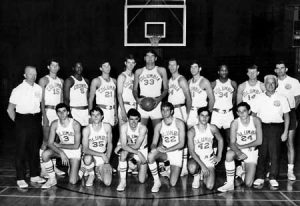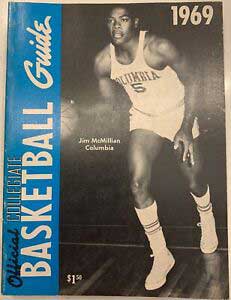Game 7: The Light Blue’s last hurrah
Columbia vs. Davidson
NCAA Eastern bracket basketball semifinal
Raleigh, NC
March 15, 1968
Like many a sports fan, I had a “Say it ain’t so, Joe,” moment (legend has it that a youthful newsie said this to “Shoeless” Joe Jackson when it was revealed he had taken part in the fixing of the 1919 World Series). That’s the moment when you realize that someone whom you revere for his talent is not merely a flawed human being like the rest of us, but fatally flawed. This happened shortly after discovering basketball in the early 50s, and my teams were both local: the New York Knickerbockers in the pros, and once more, my father’s alma mater, Columbia, for a college team. And the year before I became aware of the college game, they went undefeated until losing to Illinois in the opening round of the NCAA tournament of 1951. The team’s best player was a former New York high school star, Jack Molinas, who became my first basketball hero. In 1953, Molinas was chosen in the first round of the NBA draft by the Fort Wayne (now Detroit) Pistons, and, of course, I became a Pistons fan, and badgered my dad to pick up a Fort Wayne paper when he could from a Times Square store that specialized in carrying out of town and foreign newspapers.
My devotion did not live long. Thirty-two games into his first season, Molinas was banned for life from the NBA for gambling. Although it was for gambling done during his college years, I saw him on television in one game against the Knicks, and was horrified at his unconscionable gunning—terrible shots, most of which missed badly, and in retrospect wondered if he was shaving points that night. I took a lot of teasing from my friends about my hero’s treachery, but I learned one of life’s important lessons: admire the talent, but not necessarily the possessor of the talent.
Years later, when Molinas had become a distant bad memory, his infamy became even greater: he was one of the bookies arrested and convicted in a 1961 college point shaving scandal, and spent five years in prison. In 1975 he was murdered in what is believed to be a mob execution, and it was later revealed that he had been shaving points and gambling as early as his high school days.

Redemption for Columbia basketball came in the 1967-68 season because two New York City high school stars opted to stay close to home for an Ivy League education instead of going to one of the major collegiate basketball powers that also recruited them—Heyward Dotson, point guard from Stuyvesant in Manhattan (ironically, also Molinas’s school) and Jim McMillian, a gifted small forward from Thomas Jefferson in Brooklyn who would achieve all-America status with Columbia. Also in the starting five was a very good 7-foot center, Dave Newmark; a tough, hard-working power forward, Roger Walaszek, and a first-rate outside shooter, Billy Ames, who might have set 3-point shot records if there were such a thing in 1968. Jack Rohan, the coach, was a player on Columbia’s previous NCAA team in 1951.

Following the team’s season was not easy in the pre-Internet, ESPN era, although at the time I lived in New Haven, CT, close enough to New York to get the papers from there and a few New York television stations, but, needless to say, Ivy League basketball was not a priority then or now. The team lost three in a row in December, all on the road, but got its first national attention when it beat three ranked teams, including #2 Louisville, to win the Holiday Festival Tournament at Madison Square Garden, and went on to win 16 straight games, one of which I got to see in person when they played Yale, a tough game with Newmark injured. They lost their last regular season game to Princeton, which left them tied with Princeton for the Ivy League title, and necessitated a playoff game a few nights later which I got to see on TV, and which Columbia won. McMillian had the best game of his career and that got them into the NCAA tournament.
Back then, there were only 22 teams in the tournament, and Columbia had one of the handful of play-in games to get to what would later be called the Sweet Sixteen. They defeated LaSalle to get to the eastern semi-finals where they played Davidson, then coached by Lefty Driesell.
Columbia was behind the entire game but tied it late. With one second left, a Columbia sub was fouled, and twice Driesell called time-outs to ice him. Sadly, he missed the front end of the one-and-one, Newmark missed the put back, and Davidson won in overtime by two. Columbia finished 6th in the final AP poll.
It was my belief back then that with a few breaks, Columbia could have beaten any team in the country with the exception of Houston and UCLA, the ultimate tournament winner, then in the middle of its incredible streak of consecutive championships. Columbia had two succeeding good years, but finished second to Princeton and Pennsylvania, who went undefeated in Ivy League play those years.
There have been a few more second place finishes since then, but no Ivy League title. I suspect I will not see another such season from my Dad’s alma mater in what little time I have left, but I will always be grateful for that one shining moment in my college basketball fandom. That is all a fan can ask for, and unless you are a fan of one of the perpetual powers, all you can expect.
One ironic note: not long after Columbia’s great season, I moved to Maryland, and Lefty Driesell became the University of Maryland’s basketball coach some time later. Try as I might, I could never quite become a fan of the Terps because of him. In 1984-85, I was a grad student at UM, and on a couple of occasions saw Lefty in the student union building. It took a lot of restraint on my part not to walk up to him and chew him out for breaking my sports fan heart.